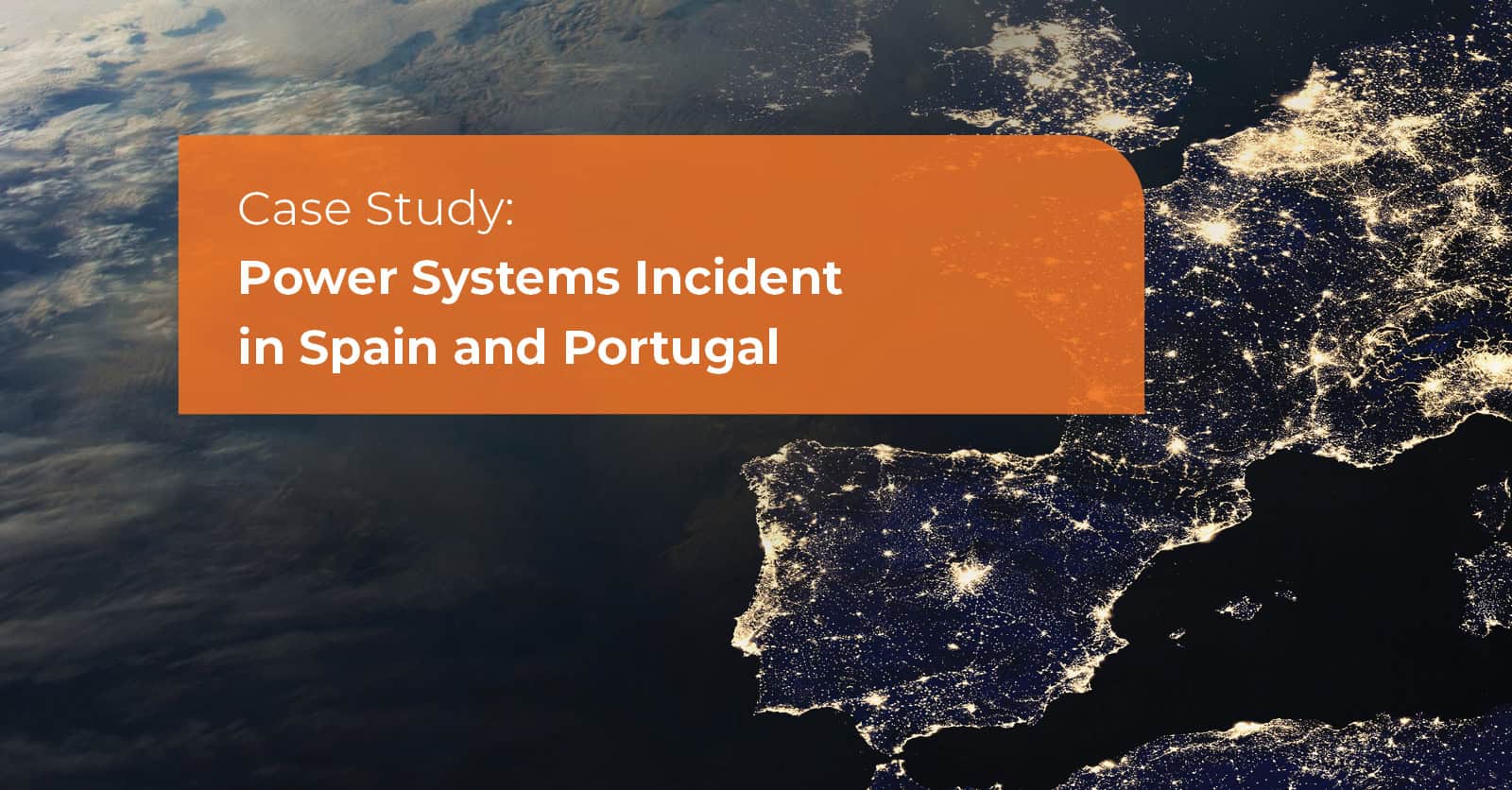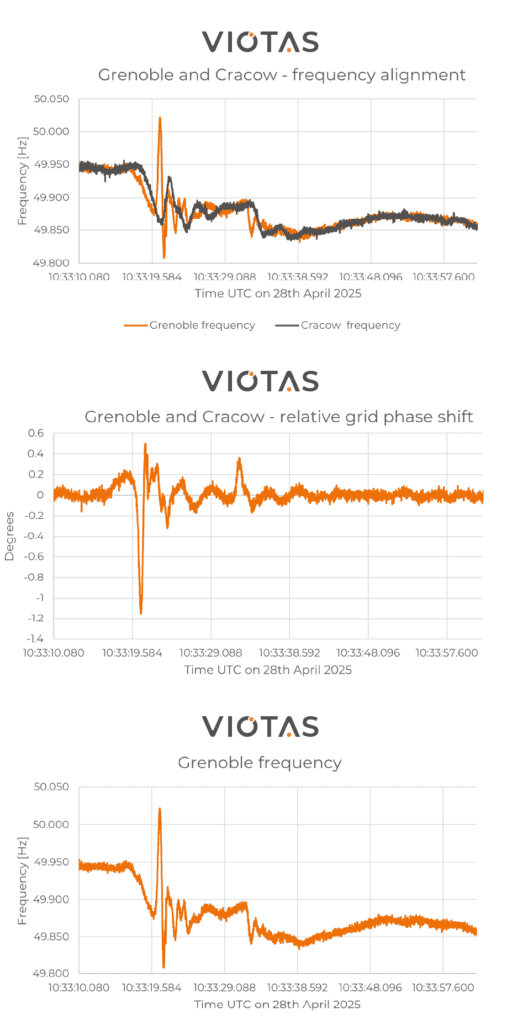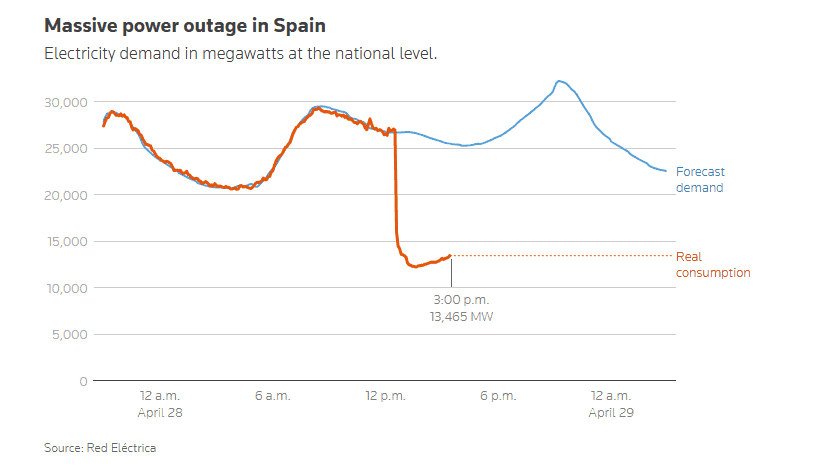
Power Systems Incident in Spain and Portugal: A Case Study
Incident overview:
On 28 April 2025, shortly after 12:30 CET (11:30 Irish Time), a significant incident occurred in the power systems of Spain and Portugal, causing a sudden loss of approximately 15 GW of generation output within about 5 seconds. This incident led to a blackout affecting both countries, with some areas near the border of France also experiencing disruptions, albeit for a brief period.
The Spanish Transmission System Operator linked the cause of this blackout to “very strong oscillation in the electrical network” that led Spain’s power system to “disconnect from the European system, and the collapse of the Iberian electricity network at 12:38”.
Outages of this magnitude are rare occurrences in Europe and has caused widespread effects across the peninsula. Hospitals were forced to activate back-up generation and suspend routine medical work, trains stopped operating, retail stores were closed amongst other major disruptions. In 2003, a blackout occurred in Italy and part of Switzerland when a powerline between both countries was affected.
VIOTAS real-time detection:
On the same day, VIOTAS systems detected a significant deviation in the grid frequency trace in both France and Poland. This anomaly proved to be the early signal of a large-scale grid disturbance that ultimately led to widespread outages across Spain and parts of France.
Our VIO Link systems recorded data that provided clear insight into the nature of the event. The frequency trace was consistent with what we classify as a Frequency Event – a pattern previously observed in other major disturbances across global markets.

While the continental European grid remained broadly synchronised, our data revealed that the system briefly slipped marginally out of sync by a few degrees. Events of this scale are rare, and such a frequency drop typically indicates a sudden loss of major power generation assets. In such scenarios, spinning inertia from conventional generators (for example, coal, gas or nuclear) helps momentarily stabilise the grid while other generators adjust output to rebalance supply and demand.
What is particularly noteworthy is that the impact of disturbance was visible in VIOTAS Innovation Hub in Kraków (Poland) in milliseconds after being detected in France. This highlights the potential for triangulation techniques – leveraging real-time data from a wider network of sensors – to help pinpoint the origin of such events fasters in the future.
Understanding grid stability and frequency management:
Power systems make use of alternating current to maintain power system stability and there must be a constant balance between the electricity being injected into the system and the electricity being consumed. Even a tiny imbalance can cause the frequency to deviate from the standard 50 Hz and larger deviations cause protection systems in the network to activate and disconnect assets from the grid to protect them from damage. These ultimately leads to blackouts.

The blackout’s initiation marked a systemic collapse of the Iberian Peninsula’s electrical grid, with ripple effects in southern France. The automatic disconnection of the Iberian grid from the European network limited the outage’s spread but exposed the peninsula’s structural isolation.
The Iberian grid is connected to France via Spain’s 2.8GW electricity interconnector and via Interconnection with Morrocco with combined 1.4GW capacity. The interconnection with the Iberian grid remains significantly lower than Germany for example’s 28.4GW interconnection with surrounding countries. Interconnectors facilitate the efficient flow of electricity across borders to where it is most needed, preventing the forced curtailment of variable renewable power. They also support the integration of more renewables into energy markets, boosting security of electricity supply.
The most common form of power outage in Ireland are caused by Storms and even the most severe in recent times Storm Éowyn, which left over 700,000 customers across the country without power did not cause a widespread system black out. Blackouts can go on for multiple days and is resolved by activating the generating plants with black start ability such as hydro and gas power plants.
While the root cause of the blackout is still being investigated, the system operators have been able to restore power to the regions of the Iberian Peninsula among other factors to the support of interconnection between France and Morrocco as well as the black start ability of hydro power plants. The incident of yesterday, has shed more light on the benefits of interconnection. Spain and France are working on the new electricity link through the Bay of Biscay which is expected to nearly double the interconnection capacity between Spain and France – increasing interconnection capacity from 2,800 MW to 5,000 MW. This would ultimately improve the security of electricity supply in both countries and facilitate further integration of renewables into the grid.
In conclusion, the recent blackout has highlighted the importance of interconnection in maintaining a stable and secure electricity supply. The ongoing efforts to enhance interconnection capacity between Spain and France will not only bolster the reliability of the grid but also support the transition to renewable energy sources. This collaborative approach is crucial for addressing future challenges and ensuring a resilient energy infrastructure.
Case study by: Ayodele Bickersteth, Market Operations Lead, VIOTAS and Adam Miarka, Head of Embedded Systems, VIOTAS



